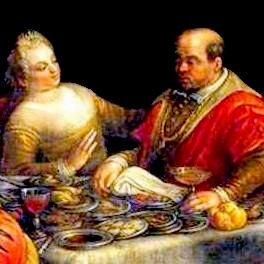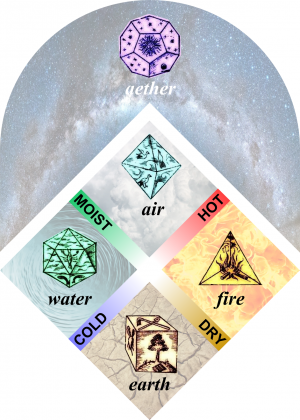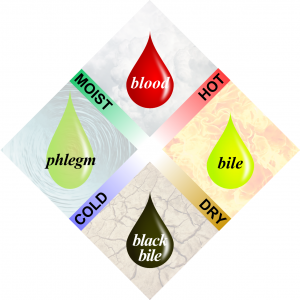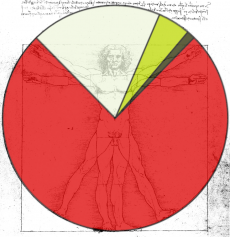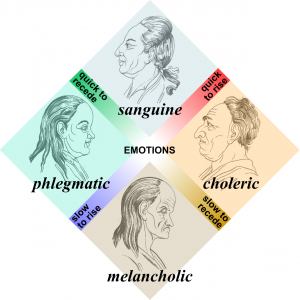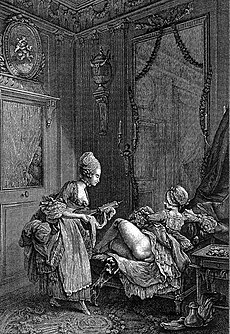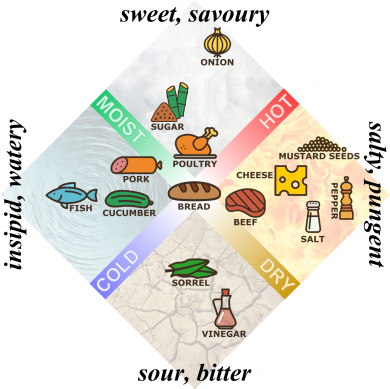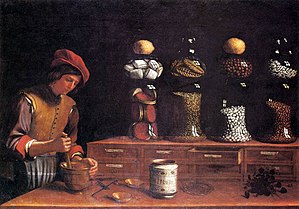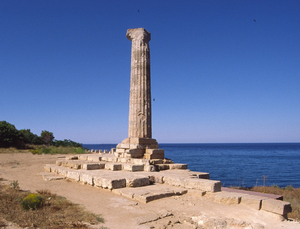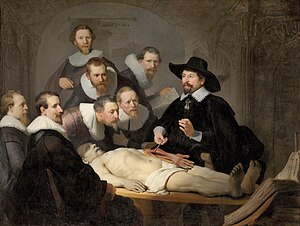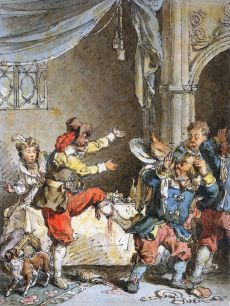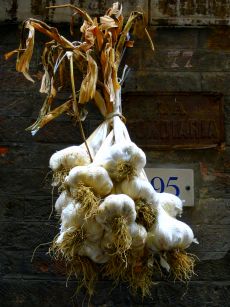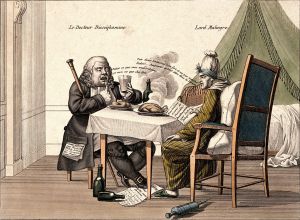Good Humour, Good Health
Did our ancestors maintain a healthy diet? We might assume that at the very least they wanted to. People have always wished to be fit and, since times immemorial, they’ve known that their health depends on what they eat. But did they know how to? Was a healthy diet even possible before anyone ever heard of calories, vitamins, proteins, carbs, lactose, gluten, allergies and food intolerances?
Well, yes, it was. Just like we (or some of us, at least) try and eat healthy, informed by the latest science, so did our forefathers and foremothers follow diets that were in line with the science that was available to them at the time. Not necessarily the latest science, though. As recently as some 500 years ago, the older the science, the more trustworthy it seemed; scholarly research wasn’t so much about making new discoveries as it was about “continuous and sublime recapitulation”.[1]
Anyone reading about old European cuisine will sooner or later come across the term “humoral dietetics”. So let’s take a closer look today at the humoral theory which held sway in Europe for ages, until as late as the 19th century. But to understand what it’s all about, we’ve got to start with the basics, that is, the ancient ideas about the structure of matter and the workings of the human body. So let me invite you to travel in time to, say, the early 17th century and to a short lecture in physics and physiology according to the state of scientific knowledge at the time.
Elementary Particles
The world is made of invisibly small particles of various shapes and qualities. They come in a few kinds which correspond to the following elements: earth, water, air and fire. A single particle of each element has the shape of a regular convex polyhedron (also known as a Platonic solid). The particles of earth are cube-shaped, cubes being the only Platonic solids which can be arranged to fill space completely, which is why earth comes in solid phase. Water particles are little icosahedra (20-faced solids), which are most similar to a sphere, which is what makes water run smoothly through your fingers. Fire burns because its particles have the form of a (four-faced) tetrahedron with pointy vertices. A particle of air, which is also gaseous, but not as light as fire, is an octahedron, which has eight faces, or twice as many as a fire particle.
The problem is that there are exactly five regular convex polyhedra (which was mathematically proven already in antiquity). Which means there must exist a fifth element (also known as “quintessence”, its Latin name), which would correspond to the fifth Platonic solid, the (12-faced) dodecahedron. In the far future, Luc Besson will imagine the fifth element to take the form of Ms. Milla Jovovich’s supple body, but ancient natural philosophers thought it was actually aether, a very subtle substance of which heavenly bodies are made. As aether does not occur on Earth, we won’t be paying any more attention to it.
The remaining four elements may be described by a pair of characteristics: hot / cold and moist / dry. And so, earth is cold and dry; water is also cold, but moist; air is moist, but hot; and fire is, obviously, hot and dry. Every single thing, substance and living being is composed of particles of these four elements in various proportions, which determines each thing’s own complexion. Something which contains, say, more particles of fire and fewer particles of water is of hot and dry complexion – in a higher or lower degree, depending on the dominance of fire in the thing’s elemental composition.
The Four Humours
So far, so good? Now let’s see how all this connects to the way the human body works; in other words, the basics of Galenic humoral theory (we’ll talk about Galen himself later on).
The human body, as the pinnacle of divine creation, is a reflection of the universe in a micro scale, so it must consists of the same four elements as everything else. What determines the complexion of a human organism are chiefly the four bodily fluids known as humours. Each humour has a set of characteristics corresponding to one of the four elements.
The most important and dominant humour is blood (known as “haima” in Greek and “sanguis” in Latin). The other three are: phlegm, bile (or choler, from Greek “khole”) and black bile (or melancholy, from Greek “melas”, “black” + “khole”, “bile”). To be honest, no one has ever seen that “black bile”, but it must exist, otherwise the number of humours wouldn’t match the number of elements. Blood is moist and hot, like air; phlegm is moist and cold, like water; bile is dry and hot, like fire; and black bile is dry and cold, like earth. This is very important, so you may want to learn this little poem by heart:
Four humours reign within our bodies wholly, | ||||||
| — The Englishman’s Doctor, or the School of Salerne, translated by John Harington, London: John Helme, 1609, p. C3 * It may seem that the rhyme is off in the last verse, but “like” was actually pronounced “leek” in Late Middle English.
Original text:
|
Where do these humours come from? Food. All that we eat and digest travels to the liver, where it’s converted into blood. From the liver, the blood is transported through veins to other organs – firstly, to supply them with nutrients, and secondly, to convert the blood into other humours. The brain is where the blood is made into phlegm; the two kinds of bile are produced closer to the liver: the regular yellow in the gallbladder and the black in the spleen. Other bodily fluids are produced in other organs still; for example, in the testicles, blood is converted into male seed (that is, semen), while in the ovaries, it is turned into female seed (which looks just like blood and is secreted out of a woman’s body roughly once a month). As for the role that the heart and lungs play, the Galenic theory doesn’t really hold much water, so we’re just going to ignore it. It suffices to say that arteries, coming out of the heart, distribute blood enriched with pneuma, a special airy substance which is responsible for all those vital processes that can’t be explained in any other way.
The human body doesn’t contain all four humours in equal amounts. Blood, as I’ve mentioned, is the most abundant one, while the elusive black bile, the least. The perfect proportion is such that for each part of black bile there are four parts of regular bile, four times as many parts of phlegm and four times as much blood as the phlegm. This perfect balance, however, is never found in real life. Each person’s humoral complexion is more or less out of balance; there’s too much of this humour or not enough of that. Mind you, there’s no such thing as “bad humour”; there’s only an imbalance of humours. Just as there’s no such thing as a perfectly healthy individual; everyone is more or less ill. Therefore, the goal of medicine is simple: to correct the amount of humours in the patient’s body in order to bring it as close to the perfect balance as possible.
The humour of which we happen to have too much determines our temperament, which in turn influences what we look like, how we behave and what kind of illnesses we’re likely to suffer from. A person of sanguine temperament, that is, with too much blood, has smooth, ruddy skin, an oval face, wavy hair and is generally well built. A choleric, or someone with too much bile, has dry, yellowish skin, fair hair with a predisposition to baldness, sharp facial features and prominent veins. You can tell someone is a melancholic, with overabundance of black bile, by their dark skin that is cold to the touch, a square face, small eyes, narrow lips, dark and sparse hair and a skinny body. Finally, a phlegmatic is characterised by delicate, moist skin, a soft, round face, fair hair and a predisposition to obesity.[2]
As for the emotional side of the temperaments (which is what “temperaments” will still mean in the 21st century), they can be distinguished by the rate at which emotions rise and recede in a given person. In sanguine people, emotions are quick to rise, but just as quick to recede, which makes them well-balanced extroverts, jovial and sociable. This is usually the most socially acceptable temperament, which is not surprising, as the predominance of blood, the most important of humours, is the least noxious. In cholerics, feelings rise quickly, but take time to recede, so if they lose their temper, as they often do, they’re not going to calm down anytime soon. The cholerics are extroverts, but unstable ones, impatient, bold and expansive. Their explosive personality may be irritating, but they often exhibit good leadership skills. For phlegmatics, it’s the other way around; emotions are slow to rise, but quick to recede, which makes them dull, calm, patient and introverted. As for melancholics, they’re unlikely to lose their cool, but once they do, it’s very hard for them to get it back. Their emotions tend to pile up faster than they recede, which results in their propensity to depression or a kind of distress known as spleen (after the organ which secretes the black bile).
Each person has their own temperament, but it doesn’t mean that it stays the same throughout your life. A child’s temperament is generally closer to sanguine, but becomes more choleric during adolescence. Your organism becomes dryer as you age, so an adult is more prone to melancholy. Finally, in the old age, the body is still dry, but it tends to ooze an increased amount of phlegm, indicating a more phlegmatic temperament. We also go through a similar cycle each year; spring, being hot and moist, intensifies the sanguine temperament; summer, hot and dry, aggravates the choler; autumn, which is cold and dry, reinforces melancholy; and winter, being cold and moist, helps the phlegm to build up. It’s important to keep these ageing and seasonal changes in mind when developing a sound dietary regimen.
The various things that our health depends on may be divided into three broad categories:
- the naturals, or internal factors, which include the aforementioned elements, humours, temperaments, internal organs and pneumas;
- the non-naturals, or external factors, which are independent of our innate humoral complexion;
- the contra-naturals, or pathogens.
Therapy typically involves fighting the latter, but also correcting the amount of humours, if something throws your humoral constitution even more off balance that usual. For example, if the symptoms include fever and profuse sweating, thus exhibiting an overabundance of the hot and moist blood, the therapy may involve bloodletting. But if you think bloodletting to be the Galenic cure-all, then think again. If it’s a humour other than blood that the medic finds to be superfluous, then it’s that humour that must be regulated. Possible procedures include applying emetics, laxatives, carminatives, etc. Did you know that great lords pay a great deal of money for the beneficial enemas prescribed for them by their personal physicians?
But on an everyday basis, prevention, as any doctor will tell you, is better than cure. This is done by controlling the six “non-naturals”, which include: food and drink, sleep and wakefulness, excretions and retentions, exercise and rest, air, and mental affections. If you need help remembering them and you speak German, then you may use the following mnemotechnic, designed in the early 17th century by a Tyrolean doctor (who added God as the seventh “non-natural”):
| Gott | God | |
| Essen und trincken | Food and drink | |
| Schlaffen und wachen | Sleep and wakefulness | |
| Oede oder Ringerung deß Überfluß | Abstemiousness | |
| Nutzen oder Übung des Leybs | Exercise | |
| Dauglich Lufft | Fresh air | |
| Trost des Gemüths | Peace of mind | |
| GESONDT | HEALTHY | |
| — Hippolytus Guarinonius: Die Grewel der Verwüstung Menschlichen Geschlechts, Ingolstadt: 1610; quoted in: Klaus Bergdolt: Wellbeing: A Cultural History of Healthy Living, trans. Jane Dewhurst, Polity Press, 2008, p. 200 | ||
All this boils down to the idea that a hygienic lifestyle is crucial for good health. Out of the six non-naturals (let’s leave God out of this), food and drink seem most important, though, at least if judging by the amount of space devoted to dietetics in medical handbooks. In any case, humoral medicine doesn’t really distinguish between aliment and drug; every medicine is food and every food is medicine. And this is where we’re finally getting to our main question: what is the correct humoral diet?
Humoral Diet in Theory
As you might have already guessed, a healthy, well-balanced diet combines foodstuffs in such a way that will help cancel their humoral complexions out; things that are hot should be mixed with cold ones, just like foods that are moist are best paired with those that are dry. A perfect balance is not advised, however, because, as we know, every person is already somewhat off-balance. Therefore, you should follow a personalised diet that will help correct your own humoral constitution. If you’re a choleric, for example, then you should eat more watery (that is, moist and cold) foods, while avoiding those akin to fire (dry and hot). And bear in mind that your personalised diet should be modified as you age, as well as constantly adjusted for the season of the year and any current afflictions. There is no single diet that is fit for all; a regimen that is designed for one individual may be harmful to another. From the point of view of humoral dietetics, the 20th-century food pyramid, which anyone can consult and follow, makes no sense.
Alright then, but how do we know the humoral complexion of every single foodstuff? Well, there are some general rules you can follow. First of all, all animals and plants take on the characteristics of the environment they live in. Birds, for instance, fly in the air, so they are hot and moist (wild birds more so, poultry less). Fish are moist and cold, just like the water they live in. Pigs, which wallow in mud, have a similar complexion, but to a lesser degree. Other four-legged animals, which graze in the open sunlight, such as cows and sheep, are hot and dry. Vegetables grow in the dirt, which makes them cold and dry – unless they evidently contain a lot of water, like cucumbers do, in which case they are cold and moist. Just like in humans, there are also differences between individual specimens within a single species; young animals are generally moister, becoming drier as they age. Males are less moist than females, although their dryness may be mitigated through castration. Wild game is also drier than its domesticated counterparts, so while pork is moist, a wild boar is going to by rather dry.
In case of doubt, you can use taste as a good indicator. Things that taste sweet are often humorally close to air; sugar is hot in the first and moist in the second degree. Foods that are sour or bitter are akin to earth; vinegar is cold in the first and dry in the third degree (this is also why, even in the 21st century, tart-tasting wines will still be referred to as “dry”). Salty or pungent flavours indicate humoral affinity to fire; salt is hot in the second and dry in the third degree, while black pepper is both hot and dry in the fourth degree (and of course, long in the future, the word “hot” will still be used to describe spiciness as well as temperature). Finally, things that are insipid or watery are typically cold and moist; spinach, for example, is cold and moist in the first degree.
But that’s not all yet. You can modify the natural humoral complexion of a given ingredient by giving it the right thermal treatment. I suppose you won’t be surprised to learn that roasting and baking makes things not only hotter, but also drier; frying dries them out, but to a lesser degree; and boiling adds moisture to your dish. This is why beef is good for boiling or stewing, but never for roasting, while pork – to the contrary – is good for the grill or the spit, but not for the pot. Veggies and fruits are for the most part so cold that you should almost never eat them raw; even lettuce should be at least scalded with boiling water before serving.
If you wish to neutralise the humoral properties of one or more of your ingredients, then a rather obvious method is to mix them with ingredients that have opposite complexions. For example, fat is rich in water, so you can temper the dryness and hotness of red meat by larding. Sugar (moist and warm) is commonly added to most cold dishes, even if these aren’t really desserts in the 21st-century sense. The natural moistness of fish is often counterbalanced by sprinkling it with vinegar or lime juice. This general neutralisation method is even more effective, if you can break down the ingredients into tiny bits and mix them all thoroughly. You can, for instance, mix cold vinegar with hot mustard seeds, but it’s better to first grind the seeds down to a paste – which, incidentally, is how you make mustard. This is why mortars, pestles, graters and sieves are among the most important kitchen utensils of an Early Modern kitchen.
The vast majority of spices and herbs (especially dried) is hot and dry, which makes them perfect for tempering the phlegmatic nature of some meats, like pork. Sprinkling, though, is not as effective as coating, hence the great popularity of thick, spicy sauces. Even better is to mix spices with aspic (which, in itself, is cold and dry) and pour this mixture onto meat, creating a galantine, one of the favourite dishes of medieval Europe. It’s also important to give the various ingredients enough time for their elements to neutralise each other. In some extreme cases, you may have to start the process of combining the ingredients while one of them is still alive. Hence recipës which instruct you to kill lampreys by drowning them in wine, bury live eels in salt or force-feed a well-fattened capon with vinegar.
| Take a live capon, pour wine vinegar down its gullet through a funnel, bind it and hang for five hours. Pluck it, gut it, and roast it in the usual manner or boil it as you like. | ||||
— Stanisław Czerniecki: Compendium ferculorum albo Zebranie potraw, Kraków: w drukarni Jerzego i Mikołaja Schedlów, 1682, p. 36, own translation
Original text:
|
Any questions? No questions. Well, no, there is one:
Whose Idea Is It?
Before we discuss the practical side of humoral dietetics, I’d like to give you a bunch of names and dates related to the history of the theory I’ve just summarised. If you’re easily bored by such details, then you can just skip this section.
If you’re still here, then I’m inviting you to yet another voyage through time and space, all the way to Croton, a Greek town at the tip of the Italian Boot, in the earlier half of the 5th century BCE. The town’s intellectual and religious life is dominated by the sect of Pythagoreans. Yes, this is a time when celebrity mathematicians are a thing. Sadly, after Pythagoras had died, his followers were quick to turn his science into a dogmatic religion, which they observe by worshipping numbers and by refraining from eating meat and legumes. Instead of elegant mathematical proofs, they’re now content with “the Master said so” as an argument. A few, however, preferring to think for themselves, have managed to wriggle themselves out of the cult. Among them is Empedoclës of Acraga, a Greek colony on Sicily. What he’s particularly interested in is the structure of matter. Earlier thinkers, who lived in Ionia on the western shore of what will once be called Turkey, were trying to identify the primordial substance, from which all other matter derives, proposing various specific elements: Thalës of Miletus suggested water; Heraclitus of Ephesus, fire; Xenophanës of Colophon, earth… Empedoclës, who proved the existence of air in a simple experiment with a water clock, tried to reconcile them all by proposing not one, but four primordial substances, that is, earth, water, air and fire. It will take one more generation for Plato to add aether to this number, so that he can assign to each of the five elements one of the five regular polyhedra, including the recently discovered dodecahedron.
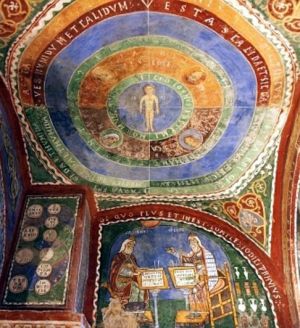
In the meantime, another former Pythagorean, who was born here, in Croton, and who goes by the name Alcmeon, is doing natural philosophy with a medical bent. Dissecting human corpses is forbidden for religious reasons, but his studies on animal eyes and brains, have led him to the conclusion that it’s the brain, rather than the heart, that is the seat of mind and emotions. Similarly to the Pythagoreans, Alcmeon views the world as a constant struggle of opposites. This includes the human body, where warmth competes against coldness, moistness against dryness, and so forth. A balance between them all is what keeps you in good health, while the predominance of any one quality leads to illness.
Hippocratës of Kos, born about half a century after Alcmeon, will eventually combine the latter’s theory with Empedoclës’s by assigning one humour (including the imaginary black bile) to each of the four elements in order to explain the struggles of hot vs cold and moist vs dry. He will be also known for introducing the general rule that the physician’s duty is to make the patient feel better or at least not worse; and for contributing so much to medical theory that it becomes a stand-alone scholarly discipline. And all this without ever peeking inside a human body. This opportunity will only become available in the following century (4th BCE) to doctors working in Alexandria, such as Herophilus of Chalcedon and Erasistratus of Ceos. This they will owe to the first Greek rulers of Egypt, of the house of Ptolemy, who, for the benefit of science, will allow dissections of human corpses to take place on the premises of the Alexandrian temple of the muses (known as a “museum”, but really more like a university).
Much later, under the Roman Empire (1st–2nd centuries CE), Greek medics working in what will once be Turkey, will once again be only allowed to dissect animals (leading, for example, to a long-held notion that the human liver has not two, but five lobes, like in a dog) and will only ever have the chance to study human anatomy while looking after wounded soldiers and gladiators. What Dioscoridës of Anazarbus and Galen of Pergamon will be remembered for is summarising all medical knowledge in books that will be read by generations of medics for centuries after the works of their predecessors will have gone up in smoke together with the library of the Alexandrian museum. Galen’s book, in particular, will be crucial for preserving the theory of humours, which will come to be known as Galenic theory.

Like much of the achievements of the Greco-Roman civilisation, Galenic medicine will be largely forgotten after the fall of the western part of the Roman Empire, but will survive in its Byzantine part, whence it will be gleaned by the Arabs and from them, by the Persians. The man who will make the greatest contributions to further developing the theory will live in 11th-century Uzbekistan under the name Abu Ali al-Husayn ibn Abdillah ibn al-Hasan ibn Ali ibn Sina (or Avicenna for short). In the following century, the medical knowledge preserved and expanded by the Muslims, will filter back into western Europe thanks to, among others, Constantine the African, who will bring it from Tunisia to Salerno, Italy. It’s in Salerno where Europe’s first medical school will be located and where Greek medical texts will be translated from Arabic and Hebrew, the chief languages of medicine. This is how Galen, along with “his” humoral theory, will be rediscovered in Europe and popularised among aristocrats by such court physicians as Michele Savonarola (his better-known grandson, Girolamo, will study medicine too, but then he’s going to quit his studies and get busy with religion and politics instead). Finally, in the 1470s, Bartolomeo Sacchi (better known as Platina) will publish the first ever printed cookbook, De honesta voluptate et valetudine (Of Honest Pleasure and Good Health), which will introduce wider European populace to recipës marrying the pleasure of eating and humoral medicine.
In the 16th century, after the discoveries made by da Gama, Columbus and others, Europeans will finally realise that if ancient authorities got it wrong about geography, then it’s possible they also got it wrong about other things. It will be the time of the first medics to question Galenic theory, with Philippus Aureolus Theophrastus Bombastus von Hohenheim (or Parecelsus for short) at the helm. Two years after his death, though, all works of Galen will be finally published in print, in the Greek original, leading to new translations and a renewed interest in Galenism. By mid-17th century, with European book market finally saturated with humoral medical-dietary handbooks, Galen’s authority will have been thrown into doubt once again, following the discoveries of the likes of Andries van Wesel (or Vesalius, who will prove Galen wrong about the structure of human heart), William Harvey (who will discover that veins and arteries form a closed circuit) and Jan Baptist van Helmont (who will show that digestion is due to gastric acids and not to an “inner heat”). But all that is not say that humoral dietetics will have been completely forgotten.

|
Humoral Diet in Practice
And this way we’ve travelled back to the 17th century. Now that we know more or less what humoral theory is, let’s see how it can be put into practice. Let’s begin with a fairly obvious observation (which will still stand in the 21st century) that usually the only people to think about healthy eating are the ones who can afford to do so. The poor are just happy, if they have anything to put into their pots. Those with a middle income (and who are literate) may be able to buy dietary handbooks to try and design their regimens by themselves. But only the most affluent can afford to employ a private medic/dietitian whose job would be to make sure that nothing unhealthy finds its way onto their lord’s table.
At a great lord’s court, every meal is a feast, not just for the lord himself, but also for his family, guests and major retainers. How, then, do you ensure that each person at the table gets a diet that is appropriate for their own particular temperament? The only way to do so is to serve a variety of dishes with different humoral qualities all at once and let each diner pick whatever their medic advised them to eat (or what they’ve read is good for them in a book). Known as “service à la française”, or service in the French way, it’s been the predominant way of serving food at banquets in Europe since the Middle Ages and will continue to be until the 19th century, when “service à la russe”, or service in the Russian way, will take over, with each dish served to each diner separately in a strict order.
But does it really work? After all, a doctor may advise, recommend, maybe even gently admonish, but he must never forget that he is his lord’s servant. In fact, it’s not rare for a patient, unused to being ordered around, to diagnose his illness and plan his own therapy by himself, summoning the doctor only to do what the patient ordered, as in: now you will give me an enema. So how can a dietitian make sure that his employer eats only what’s good for him? Sometimes all a doctor can do is complain in general terms, which is exactly what John Archer, court physician to King Charles II of England, does.
| I know the people of all qualities do commonly feed upon what comes to table, be it what it will, without considering the nature or qualities of anything, or agreement, or disagreement to their constitution, so it do but please their palate; by which means diverse have and do dig their graves with their teeth […] |
| — John Archer: Every Man his own Doctor, vol. I, London: self-published, 1673, p. 18 |
So on the one hand there’s the doctor griping about unruly patients who prefer to eat tasty rather than healthy, and on the other, there’s the patient, suspecting his own dietitian of trying to starve him to death. It’s exactly this kind of a stereotypically authoritarian physician who served at the court of Sancho Panza, the former squire to Don Quixote. Throughout Sancho’s dinner he would stand at his lord’s side and order the servants to take away every dish as soon as it was put in front of the hungry Panza (who certainly liked to eat, as you can even see by his last name, which is the Spanish word for “belly”).
| I, señor, am a physician, and I am paid a salary in this island to serve its governors as such, and I have a much greater regard for their health than for my own, studying day and night and making myself acquainted with the governor’s constitution, in order to be able to cure him when he falls sick. The chief thing I have to do is to attend at his dinners and suppers and allow him to eat what appears to me to be fit for him, and keep from him what I think will do him harm and be injurious to his stomach; and therefore I ordered that plate of fruit to be removed as being too moist, and that other dish I ordered to be removed as being too hot and containing many spices that stimulate thirst; for he who drinks much kills and consumes the radical moisture wherein life consists. | ||||||
— Miguel de Cervantes: The History of Don Quixote, translated by John Ormsby, Wikisource, 1885
Original text:
|
Sancho would fire the doctor right after his first meal. And while this one is fictitious, real-world dietitians who wanted to keep their jobs had to learn how to adjust medical theory to their employers’ expectations and how to come up with dishes that are not only healthful, but also tasty, in line with religious commandments, available in the local climate and, last but not least, allowing them to show off their affluence.
Actually, let’s start with that last criterion: how can dietetics help maintain the current (God-given) social order? How do you make sure that peasants and town folk don’t even dream of eating the same food that the nobility does? One way, which has been practised for a long time, is to simply forbid them to eat above their station by enacting sumptuary laws. But it’s not a very effective one; tell a man this or that dish is too elite for him to eat and he will make a point of eating it only to show that he does belong to the elite. But what if you made him believe that such food would make him sick? This is where the dietitians come in. All they’ve had to do is to demonstrate that the humoral constitution of those who engage in physical labour, in close contact with earth and sun, is completely different from the humoral makeup of those who were born not to work. And if so, then, absolutely logically, whatever is healthy for the latter is deleterious to the former and vice versa. Farmers, porters, soldiers, sailors and the like should never consume fresh white bread, poultry or fruits, as these foodstuffs, while perfectly good for the high-born, would only serve to plaster their stomachs. And, conversely, heavy food that befits working people, such as stale rye bread, gruel, cheese, salted herring, legumes and root vegetables, would be completely indigestible for the higher tiers of the society.
For example, here’s what a Polish 16th-century pharmacist had to write about as pedestrian a vegetable as garlic:
| Garlic, as Galen writes […], is hot and dry in the fourth degree […] Garlic is irritating and burning; it hurts, dries and bloats the stomach, it induces thirst, makes the head spin and clouds the eyes, therefore wise men do well to be wary of it. […] Garlic is greatly beneficial […] to those who travel to foreign lands and overseas, especially where there are venomous reptiles and noxious, foul-smelling waters. Likewise, it is good against the plague, but only to gross people (peasantry), who are accustomed to garlic, […] because it amplifies their innate heat and helps burn all excess matter; but in a luxurious man it does much harm. | ||||
— Marcin z Urzędowa: Herbarz polski, to jest o przyrodzeniu ziół i drzew rozmaitych, i innych rzeczy do lekarstw należących, Kraków: Jan Firlewicz, 1595, p. 18, own translation
Original text:
|
Long story short, garlic grows in the dirt, it has a sharp flavour and stinks, so it’s potentially harmful to people who are used to luxuries. Peasants, though, who are used to eating garlic, may devour it without fear. Among many stories meant to remind peasants of their place, there’s a particularly interesting one written by Sabadino degli Arienti around the time when Columbus was sailing in search of India. It’s about a valet who was nagging his lord to make him a knight. The tired nobleman eventually conceded, but not without teaching his valet a lesson: he gave him a coat of arms sporting a head of garlic under a golden sun in a blue field and, for the crest, a virgin pinching her nose shut. The blue background and the sun symbolise air and fire, which in themselves are noble elements that are perfectly fit for noble heraldry, but in this context they testify to garlic’s drying and heating properties (in the fourth, almost lethal, degree). The moral of the story is obvious: garlic will always stink and a peasant will always be a peasant.[3]
There’s only one problem here: garlic is tasty. And it’s not just the peasants who find it so. Why then should the nobles abstain from eating something that makes food so flavourful? Thank God for a loophole: you can ennoble lowly foods like garlic by combining them with more exclusive ingredients. Degli Arienti himself admitted in the end that “garlic is always food for peasants, and this even when it is sometimes artificially civilised by inserting it into roasted geese.” And this is the difference between garlic and a peasant: one can hope for eventual social advancement, the other cannot.[4]
If we were able to bend Galenic theory for the purpose of justifying social inequality, then perhaps we can also use it to justify geographic differences in what people eat? In the Middle Ages, people throughout Europe were trying to eat according to the same ancient nutritional doctrine which they read quite literally. But eventually those in the north realised that Hippocrates and Galen had lived in the Mediterranean basin. Why assume that what was good for them is also good for those living in other climate zones? Northerners, after all, have different temperaments than the southrons, so it’s only natural that they should follow a different diet than the Greeks and Romans did. But how do you know what is good for the northerners? Well, it’s simple: whatever food their organisms have got used to over the centuries. In other words, if there’s something a given nation really likes to eat and drink, then this is what is healthy for them. Perhaps wine was good for Galen, but the Dutch are more suited to drinking hoppy beer; ancient dietary experts may have preferred tender veal over beef, but beef and mustard work better to offset the cold climate of the English; and the Scots, living in harsher climes still, may even safely consume oatcakes, even if these would surely make everybody else sick. It’s due to this splendid discovery that separate national cuisines could arise in Europe.
What else can we justify with humoral dietetics? Let’s see… What about religious fasting? Have you ever wondered why eating meat is forbidden during a Catholic fast? Well, that’s because red meat heats your body and strengthens then choleric and sanguine humours, which are conducive to promiscuity and other sinful carnal pleasures. Fish, on the contrary, cools your body down and tempers your proclivity to sin, which is why it is allowed during lean periods. Such periods include Lent, Advent and the eves of various holidays, as well as so-called Ember Days, which include three days (a Wednesday, a Friday and a Saturday) in each quarter of the year. It would be difficult to find a theological or liturgical rationale for these quarterly fasts, but what you can find is a humoral reason.
| For the first time, which is in March, is hot and moist. The second, in summer, is hot and dry. The third, in harvest, is cold and dry. The fourth, in winter, is cold and moist. Then let us fast in March […] for to repress the heat of the flesh boiling, and to quench luxury or to temper it. In summer we ought to fast to the end that we chastise the burning and ardour of avarice. In harvest for to repress the drought of pride, and in winter for to chastise the coldness of untruth and of malice. | ||||||
— Jacobus de Voragine: The Golden Legend: Lives of the Saints, Aeterna Press, 2015
Original text:
|
That’s fine, but if ancient dietary theory has become so flexible in its modern practice, wouldn’t it tempt people to bend it some more and simply declare that any food you’re personally fond of is good for you? You bet it would! Already in the 16th century, Michel de Montaigne knew well that it’s all a sham.
| If your physician does not think it good for you to sleep, to drink wine, or to eat such and such meats, never trouble yourself; I will find you another that shall not be of his opinion. | ||||||
— Michel de Montaigne: The Essays of Montaigne, tranlated by Charles Cotton, vol. III, chapter XIII, Wikisource, 1877
Original text:
|
In the 20th century one historian will notice one curious thing: all dishes cooked according to old recipës that follow humoral dietary rules are tasty.
| […] It does not really matter whether or not we accept that the flesh of pheasant is temperately warm and temperately moist, or even that we agree with Averroes that pheasant is the supremely preferable fowl for eating, in order to enjoy a good English Mawmenee made with shredded pheasant meat, wine, sugar, rice flour, pine-nuts, dates, ginger, cinnamon and cloves. We don’t have to be aware that crayfish are both warm and dry in the second degree in order to be convinced that the Italian Pastello de gamari is delectable when it combines the meat of crayfish, that is first boiled and then fried in olive oil and onion, with pepper and saffron, ground walnuts and filberts, and sugar, and then baked all together in a pieshell. And why should we care that sorrel is held to be cold and dry in the second degree, if […] sorrel verjuice is rationally combined with (bitter) orange juice in a delicious French dressing for fried sole? Or that barley is held to be cold and dry in the first degree when, boiled until thick with warm-and-moist almond milk and warm-and-dry honey, the Catalan Ordiat is such a simple yet mouth-watering delicacy? |
| — Terence Scully: The Art of Cookery in the Middle Ages, Woodbridge: The Boydell Press, 1995, p. 64–65 |
How is it possible? Did medieval dietitians and cooks conspire to bend nutritional advice to their employer’s tastes? That’s not impossible, but one can find other explanations too. For example, it could be that, from among a vast number of possible combinations of ingredients that dietitians found acceptable, cooks were able to find, through trial and error, the ones that are also tasty, while the inedible ones have been forgotten. But it’s also possible that we find these combinations tasty simply because we’ve got used to them over centuries of following a humoral diet. In the 21st century, people will still season their pork with mustard, sprinkle their fish with lemon juice and their cucumbers with salt without ever thinking that all this is actually required by the humour-balancing rule.
In any case, it’s increasingly common knowledge in our 17th century that humoral medicine is mostly a way for quacks to rip wealthy patients off. Those physicians who keep swearing by ancient theories are now ridiculed by satirists and comedians, such as Cervantes, Shakespeare and Molière. The Imaginary Invalid by the latter is perhaps the best example of this trend.
– […] What does your doctor order you for food? | ||||
— Molière: The Imaginary Invalid, translated by Charles Heron Wall, Wikisource, 1877
Original text:
|
And to wrap it up, here’s a short Polish poem to show you just how little respect humoral medicine commands nowadays.
Eating fish gives you phlegm – or that’s what you claim – | ||||
— P.H.P.W. [Jacek Przetocki]: Postny obiad, albo Zabaweczka, 1654, own translation
Original text:
|
References
- ↑ In the words of Brother Jorge in The Name of the Rose by Umberto Eco (quoted from memory).
- ↑ The Four Temperaments, in: David K. Osborn: Greek Medicine
- ↑ Allen J. Grieco: The Social Politics of Pre-Linnean Botanical Classification, in: I Tatti Studies: Essays in the Renaissance, vol. 4, Casa Editrice Leo S. Olschki, Villa I Tatti, The Harvard Center for Italian Renaissance Studies, 1991, p. 131–132
- ↑ Ryleigh Nucilli: How ‘Ennobling’ Helped Italian Aristocrats Solve the Problem of Garlic, in: Atlas Obscura, Brooklyn: 27 April 2018
Bibliography
- Maria Dembińska, William Woys Weaver: Food and Drink in Medieval Poland: Rediscovering a Cuisine of the Past, Philadelphia: University of Pennsylvania Press, 1999
- Jarosław Dumanowski, Magdalena Kasprzyk-Chevriaux: Kapłony i szczeżuje: Opowieść o zapomnianej kuchni polskiej, Wołowiec: Wydawnictwo Czarne, 2018
- David Gentilcore: Food and Health in Early Modern Europe: Diet, Medicine and Society, 1450–1800, Bloomsbury, 2015
- Jacques Jouanna: Hippocrates as Galen’s Teacher, in: Manfred Horstmanshoff: Hippocrates and Medical Education: Selected Papers Presented at the XIIth International Hippocrates Colloquium, Universiteit Leiden, 24-26 August 2005, Brill, 2010, p. 1–21
- Mary Lindemann: Medicine and Society in Early Modern Europe, Cambridge University Press, 2010
- Terence Scully: The Art of Cookery in the Middle Ages, Woodbridge: The Boydell Press, 1995
- Marta Sikorska: Smak i tożsamość: polska i niemiecka literatura kulinarna w XVII wieku, Warszawa: Muzeum Pałacu Króla Jana III w Wilanowie, 2019
| ◀️ Previous | 📜 List of posts | Next ▶️ |
| ⏮️ First | 🎲 Random post | Latest ⏭️ |
- Avicenna
- Galen of Pergamon
- Hippocrates of Kos
- Charles II Stuart
- Marcin of Urzędów
- Miguel de Cervantes
- Molière
- Michel de Montaigne
- Bartolomeo Platina
- Jacek Przetocki
- William Shakespeare
- Garlic
- Capon force-fed with vinegar
- Ancient Greeks
- France
- United Kingdom
- Italy
- Turkey (country)
- Antiquity
- Middle Ages
- Early Modern Period
- Wine
